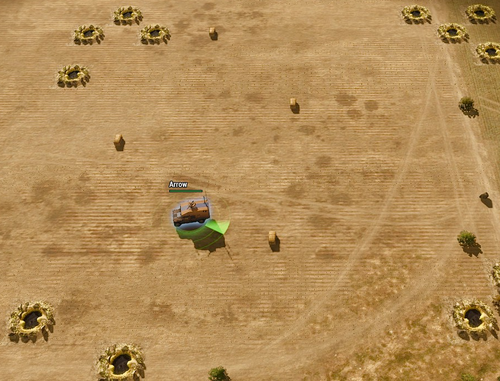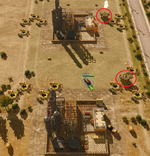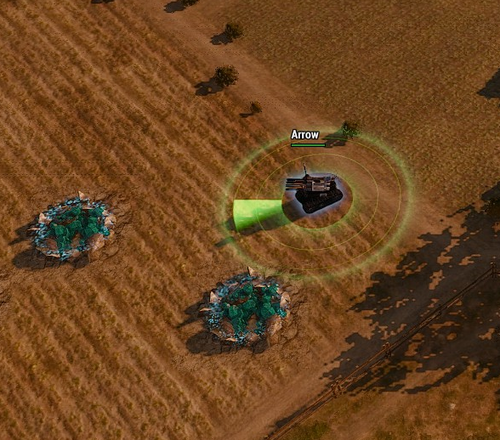
There are three resources to collect in the game, and each is collected in a similar manner. The methods of collecting, however, differ from faction to faction.
In order to gain resources, they must first be identified on the map. Identifying resources is capable only by a specialized recon unit, identified by its green aura. Resources come in fields consisting of six to sixteen resource nodes. Refineries built at these resource fields will harvest the resources from each node, one at a time, and stockpile the results. The resources must then be collected by a transport unit and brought back to your headquarters or other storage facility in order for it to be usable.
When attacking enemy refineries, be warned that refineries are notoriously explosive. Destroying a refinery will easily destroy any friendly (and unlucky enemy resource collector) units in its vicinity and will spawn fires that are deadly to infantry and vehicles.
Locating Resources[edit]
Resource fields are completely invisible and can only be revealed by a dedicated survey team. Each player begins with one such unit, and can be distinguished from other scouting units by its green scanning aura. Scanning for resources is extremely important since it reveals where enemy refineries could be and where your own will be. In addition, the resource fields in Act of Aggression are not fixed: there is a specific radius around the map where a given resource node could spawn. While it is easy to estimate where the resources will be, knowing their exact quantity and location is possible only with a scanning unit. Once a resource field is identified, a refinery must be built at its location from the player's headquarters in order to gather the resources.
Refineries and Collectors[edit]
The refinery will then automatically start draining one of the resource nodes at the field until it is depleted, adding it to the refinery's stockpile. The refinery's stockpile can be seen at the bottom of the screen with the refinery selected. It can also be seen as the number of yellow, blue, or red crates in the refinery's loading bay. The Americans' M993, Chimera's Crusher, or the Cartel's K-MAX will go to the refinery, pick up the refinery's stores, and then return it to the nearest drop off point. As these transport units do not actually harvest the resources themselves, building more of them does not necessarily result in a faster collection rate. The number of collectors assigned to a refinery is displayed as white dots beneath the refinery's health bar.
Credits[edit]

Necessary for all units, structures, and upgrades, credits are represented by dollars. They are gathered by building refineries at oil fields, which can be indicated by their golden-yellow glow. Each field has a number of resource nodes, and a refinery will switch from one node to the next automatically should its current node be depleted.

Once the oil fields are depleted, gaining credits proves considerably more difficult. Apart from their respective HQs providing 30 credits every 2 seconds, three factions can exploit Prisoners of War, which provide a one-time bonus of 500 credits upon capture and can be detained in certain structures, with each generating 4 credits every 2 seconds by default. The US Army has access to the Administrative Center, which generates 20 credits every 2 seconds.
Early-game, when resources are extremely important, one technique used is called "double refinery", in which two refineries are placed such that each covers half of the resource field. While requiring twice the resources, two refineries will also refine resources faster and can hold twice as much. This however is redundant for Chimera Refineries, as they can attach a second excavator which costs less than deploying another Refinery.
Unlike Rare Earth Elements and Aluminum, Oil takes up space until it is stored, at which point it is converted into credits. As a result, they do not need to be physically stocked.
Prisoners[edit]

When an infantry unit runs out of health, it has a chance to instead turn into a Prisoner of War instead of being destroyed. Capturing an enemy prisoner of war in this manner will immediately transport them to an American Field Hospital, Chimera Prison, or Cartel Barracks (with an appropriate upgrade). Each prisoner grants a 500 credit burst for initial capture and 4 credits per two seconds as long as they are detained. Similarly, ensure your own wounded infantry are treated by an infantry healing unit to return them to the fight.
Vehicles do not spawn wounded infantry, but instead the crew of the vehicle may bail out unless it is specifically unmanned. Vehicle crew are unarmed, slow, and will stop moving when enemy units are nearby. Enemy Pilots can be captured in the same manner that wounded infantry can. If a Pilot returns to the closest Headquarters/Prison equivalent, their respective player receives 250 credits.
Both the US Army and Chimera have upgrades that increases the chances of producing Prisoners of War in combat, and exchange them for resources. The Cartel does not have an equivalent due to their Prison equivalent being much smaller, but can double their credit income or convert them into producing Aluminum.
Only three infantry units per faction are capable of capturing wounded infantry or pilots in this manner. American infantry capable of this include the Ranger, Sniper, and Delta Force. Chimera infantry capable of capture include the FELIN, SAS, and Exosoldier. Cartel infantry with this ability include the Contractor, Punisher, and Vanguard.
Banks[edit]
Banks are no different from the average district, but have a couple of differences that make them much more valuable. Each bank has a set amount of credits, and provides 5 credits every two seconds for each occupied slot for a maximum of 30 credits with six slots. Friendly units from other players on the same team can also share Banks. The Bank also has a whopping 1000 health, far higher than other common districts, and each player starts near one. Securing and holding banks are therefore always within their best interests.
Aluminum[edit]

Utilized for more advanced units and upgrades, aluminum is a secondary resource. Chimera is notable for using more Aluminum than the other two factions, so this resource is considerably more important for them and could be considered a second primary resource.
Gathering Aluminum without relying on refineries is much more difficult. The US Army must exchange prisoners of war in their Field Hospital at a rate of 1000 per prisoner after unlocking DEFCON 2. The Chimera can build Syntech Labs, which produce 10 Aluminum every 2 seconds. The Cartel must fill a Barracks' Prison Module with five Prisoners and then convert its production to 10 Aluminum every 2 seconds while removing its credit generation.
Unlike credits, aluminum must be stored at the base until it is used. Blue crates indicate how much storage is used at each location. Structures capable of providing additional storage include the US Army's FOB and LEM facilities, the Cartel's Extension Module, and Chimera's Outpost. Buildings can teleport their aluminum stores to each other as necessary, including to other storage structures if the current drop off point is full. All factions' headquarters buildings also provide storage.
Rare Earth[edit]

Used primarily for superweapons and other high-end units, rare earth is usually used in combination with other resources. Rare earth is also usually found far away from the player's starting base and requires expansion in order to reach it, but the contrary can happen in certain maps.
Rare earth requires upgrades in order to mine. US Army only gets access to Rare Earth mining by reaching DEFCON 1, at which point they can construct Processing Plants used for the purpose. Chimera has it easy as the Rare Earth Extraction Protocol allows all of their Refineries to do so if the SHIELD and SWORD Protocols have been researched. Cartel's Refineries can be upgraded individually to extract them, although the upgrade itself is locked until Black Ops has been purchased.
The US Army can exchange each Prisoner of War for 250 Rare Earth at DEFCON 1. Chimera has it better due to a higher exchange rate (5 for 1500, or 10 for 3500) despite requiring them to fill their Prisons. The Cartel can build Underground Stock Markets which generate 4 Rare Earth every 2 seconds.
Like aluminum, rare earth must be stored at the base until it is used. Red crates indicate how much storage is used at each location, and the same rules apply. These include the Rare Earth LEM, the Rare Earth Outpost, and the Rare Earth Extension Module. Regular LEMs, Outposts, and Extension Modules can also store rare earth in addition to aluminum, but these dedicated structures will only ever store rare earth.